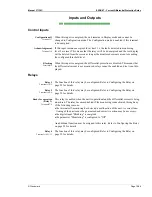
Manual 37138C
ESDR 4T - Current Differential Protection Relay
Page 14/46
© Woodward
Chapter 4.
Functional Description
Introduction
≡≡≡≡≡≡≡≡≡≡≡≡≡≡≡≡≡≡≡≡≡≡≡≡≡
The ESDR 4T is a three-phase current differential protection relay for generators, motors and transformers in
block connection (protected object). The currents flowing in the individual conductors are each measured using a
current transformer on both sides of the protected object. They form the protection area boundary or zone. All
two or three-phase short-circuits and line-to-earth faults within this protection area are detected by the ESDR 4T
as fault currents which cause tripping. The unit does not trip if fault currents occur outside the protection area. In
this way, a selective protection is guaranteed.
All 6 measuring currents are electrically isolated. The unit calculates the differential current and restraint current
internally for each phase separately. The following settings are taken into account for this:
•
Transformer vector group
•
Rated current of the protection object on the low-voltage side
•
Rated primary current of the current transformer on the high and low-voltage side
•
Voltage transformation of the transformer
During the calculation, the star connections on the windings are arithmetically converted into delta layouts to
eliminate the zero-sequence system. The different relationships between the current transformer ratios and the
voltage transformation can lead to relatively different currents even when there are no faults. In order to manage
defined ratios, the measured value on the high-voltage side is standardized so that it can be compared with the
measured value on the low-voltage side. The reference side is the low-voltage side, therefore the configured rated
current on the low-voltage side must be referred to. It is recommended that the generator rated current be used as
the reference value for unit connections.
NOTE
The measured values of the differential protection are shown as percentage values related to the con-
figured rated current.















































